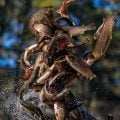How to Tie the Black & Blue Bugger
Producer: tightlinevideo
This fly I call the Black & Blue Bugger has become one of my favorite winter streamer patterns. It’s a slight variation of a Squirrel & Herl Bugger, both are a combination of a Zonker and a Woolly Bugger. Yes, you can add a bead or wire wraps for weight if you like, but I feel it fishes better weightless, off either a sink tip line or a sinking leader.
The fly starts with a size 10 Lightning Strike SN3 streamer hook. Make sure the 3X long hook is well-secured in the jaws of your tying vise. Then, load a bobbin with a spool of reasonably heavy black thread, like UTC 140.
Get the thread started on the hook shank, leaving a full eye-length space behind the back edge of the hook eye. After taking a dozen or so wraps rearward, snip off the excess tag. Continue taking touching thread wraps, all the way back to the start of the hook bend. On this hook, your thread should be hanging about halfway between the hook point and the barb.
Zonked, black pine squirrel is used to form the back and tail of the fly. The stuff has gotten a little pricey over the years, but I feel it’s well worth the expense. With the fur canted rearward, measure the hide to a hook shank in length, then separate the fur at that point and transfer the measurement rearward to the start of the bend. Take two wraps of tying thread over top of the strip, then pull the forward-pointing portion up and back and take two thread wraps around just the hook shank in front of it. Lay the strip back down on top of the hook shank and take two more tight wraps over top of it. Then, once again, pull the forward portion back and take a couple of thread wraps in front of it. I like to use a hair clip to hold the excess material back and out of the way.
Medium-sized black chenille is used to form the body of the fly. A 2-card-width segment is more than enough. Strip some of the fuzzy stuff from one end of the chenille to expose the string core. Anchor the string to the top of the hook shank, then advance your thread forward to the initial tie-in point. Begin making touching to slightly overlapping wraps with the chenille up the hook shank to form a fuzzy underbody on the fly. When you reach your thread, use it to firmly anchor the chenille, then snip the excess off nice and close.
I’ve always liked blue for wintertime flies so I’m going to use a single fluorescent blue grizzly saddle hackle to form the bugger part of the fly. With the shiny side of the feather facing you, strip away any of the super fuzzy marabou-like fibers off of both sides of the stem. You really want the remaining lowest fibers to be about a hook shank in length. Here, the lowest fibers are still just a little too long so I’ll strip them off as well. Next, snip the fibers on either side of the feather’s stem to form a small diamond-shaped tie-in anchor. This can be snipped down if necessary to make it even smaller. Once that’s done, I’ll strip a few more fibers off just the top side of the feather’s stem. This will ensure it wraps correctly.
Use tight wraps of tying thread to begin securing the tie-in anchor to the near side of the hook, in the small space behind the hook eye and end with your tying thread immediately in front of the chenille. Pull the feather forward out over the hook eye then give your bobbin an ample clockwise spin, as if you’re looking down on it, to cord up, thin and strengthen the tying thread. Begin taking open spiral rearward wraps with the corded-up thread over top of the chenille. This is effectively counter wrapping the chenille. End with your tying thread at the back edge of the chenille.
Get hold of the saddle hackle and make two or three wraps with it, one right behind the other. These wraps will help to stop the fly from spinning underwater. Then, go right into 4 or 5 open spiral rearward wraps, ending at the back end of the chenille. Use tight wraps of tying thread to anchor the feather’s tip there. Then, make open spiral wraps forward, through the hackle, cross-wrapping the delicate feather’s stem as you go. When you get to the front of the fly, sweep the hackle fibers rearward and take a couple of thread wraps to hold them back. You can then break or snip the excess hackle tip off close. If there are any trapped or wayward fibers, now’s a good time to snip them free.
Wet the fingers of your right hand and preen the hackle fibers down evenly on either side of the hook, and pull the Zonker strip forward on top of the hook shank, like so. While keeping the strip pulled tight, separate the fur above your tying thread then use it to anchor the Zonker strip with the same two, two and two wrap method as before. Using the angle of the hook eye as a guide, snip the forward-pointing excess portion of the Zonker strip off close. The idea is to trim it close without nicking your tying thread. Snip off any wayward fur or fibers.
Before wrapping the head of the fly, I’ll pick up my well-worn disc of Veniard’s tying wax and apply a liberal coat to 2-3” of my tying thread. The wax adds a tremendous amount of grip to your thread so you can wrap up at a steep angle without the thread wraps slipping forward. With everything beneath covered up, end with your tying thread at the back edge of the head.
Pick up your whip finish tool and use it to do a 5 or 6 turn, back to front whip finish, seat the knot well and snip or cut your tying thread free. A drop of head cement, here Sally Hansen Hard as Nails, applied to the thread wraps and allowed to sink in and dry, will not only keep the wraps from unraveling, but will also create a nice looking head on the fly.
It’s always a good idea to use a bodkin to make sure the hook eye is clear of adhesive before it dries.
And that’s the Black & Blue Bugger, all ready for swinging and stripping in icy winter waters.
How to Tie the Bivisible
How to Tie the Bronze Goddess











